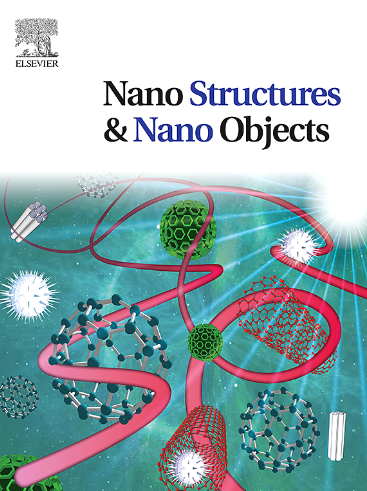Adsorption and sensor properties of NO2 and SO2 gases by Palladium and Silicon modified fullerene material: A computational study
IF 5.45
Q1 Physics and Astronomy
引用次数: 0
Abstract
The emission of various air pollutants from industrial plants, and fossil burning among others as a result of the progressive improvement in industrialization, technology, and urbanization cannot be fully curtailed. Hence, a need to detect and monitor air pollutants from a distance. Herein, the sensor performances of a newly modeled palladium-encapsulated silicon-doped carbon-based fullerene (Si-Pd@C80) nanostructured towards the adsorption of NO2 and SO2 gas pollutants have been studied through density functional theory (DFT) calculations at the PW6B95-D3/GenECP/LanL2DZ/Def2-SVP method. The energy gap of the complexes is 0.026 eV for Si_Pd@C80, 0.022 eV for NO2_n_Si_Pd@C80, 0.032 eV for NO2_o_Si_Pd@C80, 0.009 eV for SO2_o_Si_Pd@C80 and 0.017 eV for SO2_s_Si_Pd@C80 respectively. The adsorption energy of the two complexes formed after the adsorption of the NO2 gas molecule is quantified as −3.983 and −4.785 eV corresponding to NO2-n-Si-Pd@C80 and NO2-o-Si-Pd@C80 respectively while the adsorption of SO2 gas molecules on the Si-Pd@C80 surface exhibits relatively stronger adsorption than the adsorption of NO2 gas on the same surface. The conclusive report shows that the modeled palladium-encapsulated silicon-doped fullerene (Si-Pd@C80) surface might be used as a potential nanostructure material for the detection of SO2 gas pollutants.
钯硅改性富勒烯材料对NO2和SO2气体的吸附和传感器性能的计算研究
由于工业化、技术和城市化的不断进步,工业工厂和化石燃料等排放的各种空气污染物是无法完全减少的。因此,有必要从远处探测和监测空气污染物。本文在PW6B95-D3/GenECP/LanL2DZ/Def2-SVP方法下,通过密度泛函理论(DFT)计算,研究了新型钯包覆掺杂硅碳基富勒烯(Si-Pd@C80)纳米结构对NO2和SO2气体污染物吸附的传感器性能。复合物的能量差距是0.026 Si_Pd@C80 eV, 0.022 NO2_n_Si_Pd@C80 eV, 0.032 NO2_o_Si_Pd@C80 eV, 0.009 eV分别为SO2_s_Si_Pd@C80 SO2_o_Si_Pd@C80和0.017 eV。NO2气体分子吸附后形成的两个配合物的吸附能分别量化为NO2-n-Si-Pd@C80和NO2-o-Si-Pd@C80对应的- 3.983和- 4.785 eV,而SO2气体分子在Si-Pd@C80表面的吸附比NO2气体在相同表面的吸附表现出相对较强的吸附。结论报告表明,模拟的钯包覆掺硅富勒烯(Si-Pd@C80)表面可能作为一种潜在的纳米结构材料用于SO2气体污染物的检测。
本文章由计算机程序翻译,如有差异,请以英文原文为准。
求助全文
约1分钟内获得全文
求助全文
来源期刊

Nano-Structures & Nano-Objects
Physics and Astronomy-Condensed Matter Physics
CiteScore
9.20
自引率
0.00%
发文量
60
审稿时长
22 days
期刊介绍:
Nano-Structures & Nano-Objects is a new journal devoted to all aspects of the synthesis and the properties of this new flourishing domain. The journal is devoted to novel architectures at the nano-level with an emphasis on new synthesis and characterization methods. The journal is focused on the objects rather than on their applications. However, the research for new applications of original nano-structures & nano-objects in various fields such as nano-electronics, energy conversion, catalysis, drug delivery and nano-medicine is also welcome. The scope of Nano-Structures & Nano-Objects involves: -Metal and alloy nanoparticles with complex nanostructures such as shape control, core-shell and dumbells -Oxide nanoparticles and nanostructures, with complex oxide/metal, oxide/surface and oxide /organic interfaces -Inorganic semi-conducting nanoparticles (quantum dots) with an emphasis on new phases, structures, shapes and complexity -Nanostructures involving molecular inorganic species such as nanoparticles of coordination compounds, molecular magnets, spin transition nanoparticles etc. or organic nano-objects, in particular for molecular electronics -Nanostructured materials such as nano-MOFs and nano-zeolites -Hetero-junctions between molecules and nano-objects, between different nano-objects & nanostructures or between nano-objects & nanostructures and surfaces -Methods of characterization specific of the nano size or adapted for the nano size such as X-ray and neutron scattering, light scattering, NMR, Raman, Plasmonics, near field microscopies, various TEM and SEM techniques, magnetic studies, etc .
 求助内容:
求助内容: 应助结果提醒方式:
应助结果提醒方式:


